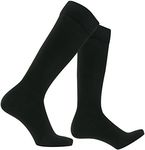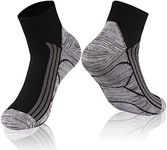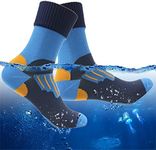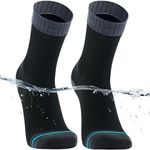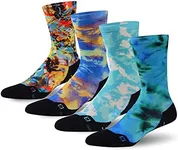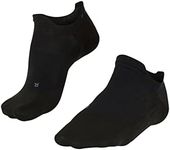Buying Guide for the Best Waterproof Socks For Hiking
When it comes to choosing waterproof socks for hiking, it's important to consider several key factors to ensure you get the best fit for your needs. Waterproof socks are designed to keep your feet dry and comfortable in wet conditions, which is crucial for preventing blisters and maintaining foot health during long hikes. By understanding the key specifications and how they relate to your hiking activities, you can make an informed decision and select the right pair of waterproof socks for your adventures.Waterproofing TechnologyWaterproofing technology refers to the method used to make the socks resistant to water. This is important because it determines how effectively the socks will keep your feet dry. Common technologies include membranes like Gore-Tex or proprietary coatings. Socks with high-quality waterproofing technology will offer better protection in heavy rain or when crossing streams. If you often hike in very wet conditions, look for socks with advanced waterproofing. For occasional wet weather, a basic waterproof layer may suffice.
BreathabilityBreathability is the ability of the socks to allow moisture and sweat to escape while keeping water out. This is crucial for comfort, as it helps prevent your feet from becoming sweaty and overheated. Breathable socks are typically made with materials that wick moisture away from the skin. If you tend to sweat a lot or hike in warmer climates, prioritize socks with high breathability. For cooler, less strenuous hikes, moderate breathability may be adequate.
MaterialThe material of the socks affects their comfort, durability, and performance. Common materials include merino wool, synthetic fibers, and blends. Merino wool is known for its softness, warmth, and natural moisture-wicking properties, making it a great choice for cold weather. Synthetic fibers like nylon and polyester are durable and quick-drying, suitable for varied conditions. Consider your typical hiking environment and personal comfort preferences when choosing the material.
Fit and SizingFit and sizing are critical for preventing blisters and ensuring comfort. Waterproof socks should fit snugly without being too tight, as a proper fit helps prevent friction and movement inside the shoe. Most brands offer sizing charts to help you find the right size based on your shoe size. If you have wide or narrow feet, look for brands that offer different width options. Always try on the socks with your hiking boots to ensure a good fit.
CushioningCushioning refers to the padding in the socks, which provides comfort and impact protection. This is important for reducing foot fatigue and preventing blisters on long hikes. Socks with more cushioning are ideal for rugged terrain and long distances, while lighter cushioning may be sufficient for shorter, less demanding hikes. Consider the type of terrain you typically hike on and your personal comfort needs when selecting the level of cushioning.
DurabilityDurability is the ability of the socks to withstand wear and tear over time. This is important because hiking can be tough on socks, and you want a pair that will last through many adventures. Look for socks made with reinforced areas, such as the heel and toe, which are more prone to wear. If you hike frequently or on rough terrain, prioritize socks with high durability. For occasional hikes, standard durability may be sufficient.


